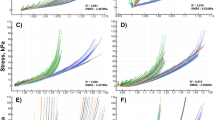Abstract
The mechanical function of soft collagenous tissues is inherently multiscale, with the tissue dimension being in the centimeter length scale and the underlying collagen network being in the micrometer length scale. This paper uses a volume averaging multiscale model to predict the collagen gel mechanics. The model is simulated using a multiscale component toolkit that is capable of dealing with any 3D geometries. Each scale in the multiscale model is treated as an independent component that exchanges the deformation and average stress information through a scale-linking operator. An arterial bifurcation was simulated using the multiscale model, and the results demonstrated that the mechanical response of the soft tissues is strongly sensitive to the network orientation and fiber-to-fiber interactions.









Similar content being viewed by others
References
Neidert MR, Tranquillo RT (2006) Tissue-engineered valves with commissural alignmnet. Tissue Eng 12(4):891–903
Tranquillo RT (2006) The tissue-engineered small diameter artery. Ann NY Acad Sci 961:251–254
Guilak F, Butler DL, Goldstein SA, Mooney DJ (2003) Functional tissue engineering. Springer, New York
Roeder BA, Kokini K, Sturgis JE, Robinson JP, Voytik-Harbin SL (2002) Tensile mechanical properties of three-dimensional type I collagen extracellular matrices with varied microstructure. J Biomech Eng 124:214–222
Fung YC (1993) Biomechanics: mechanical properties of living tissues, 2nd edn. Springer, New York
Drew DA (1971) Averaged field equations for two-phase media. Stud in Appl Math 2:122–166
Whitaker S (1986) Flow in porous media I: a theoritical derivation of Darcy’s law. Transp Porous Media 1:3–25
Driessen NJB, Bouten CVC, Baaijens FPT (2005) A structrual constitutive model for collagenous cardiovascular tissues incoporating the angular fiber distribution. J Biomech Eng 127(3):494–503
Agoram B, Barocas VH (2004) Coupled macroscopic and microscopic scale modeling of fibrillar tissues and tissue equivalent. J Biomech Eng 123(4):362–369
Stylianopoulos T, Barocas VH (2007) Volume Averaging Theory for the Study of the Mechanics of Collagen Networks. Comput Meth Appl Mech Eng 196(31–32):2981–2990
Stylianopoulos T, Barocas VH (2007) Multiscale, structure-based modeling for the elastic mechanical behavior of arterial walls. J Biomech Eng 129(4):611–618
Muller J, Sahni O, Jansen KE, Shephard MS, Taylor CA (2005) A tool for the efficient FE-simulation of cardio-vascular flow. Proc 2nd NAFEMS CFD Seminar: Simulation of Complex Flows, pp 1–10
Ku JP, Draney MT, Arko FR, Lee WA, Chan FP, Pelc NJ, Zarins CK, Taylor CA (2002) In viro validation of numerical prediction of blood flow in arterial bypass grafts. Ann Biomed Eng 30:743–752
Parker D, Taylor CA, Wang K (1998) Imaged based 3D solid model construction of human arteries for blood flow simulations. In: Proceedings of the 1998 IEEE biomedical engineering meeting. HongKong, China
Billiar KL, Sacks MS (2000) Biaxial mechanical properties of the native and glutaraldehyde-treated aortic valve cusp: part II—a structural constitutive model. J Biomech Eng 122:327–325
Chandran PL, Barocas VH (2007) Deterministic material-based averaging theory model of collagen gel mechanics. J Biomech Eng 129(2):137–147
Oda M, Iwashita AA (1999) Mechanics of granular materials. Brookfield, Rotterdam
Nuggehally MA, Picu CR, Shephard MS, Fish J (2007) Adaptive model selection procedure for concurrent multiscale problems. J Multiscale Comput Eng 5:369–386
Shephard MS, FrantzDale B, Nuggehally M, Beall MW, Klass O (2006) Coordinating models in multiscale simulations
Parasolid Inc. http://www.ugs.com/products/open/parasolid
Spatial Inc. http://www.spatial.com/products/
Garimella R, Shephard MS (2000) Boundary layer mesh generation for viscous flow simulations in complex geometric domain. Int J Numer Meth Eng 49(1–2):193–218
Luo XJ, Shephard MS, Obara RM, Nastasia R, Beall MW (2004) Automatic p-version mesh generation for curved domains. Eng Comput 20:265–285
Luo XJ, Shephard MS, Yin LZ, Obara RM, Nastasia R, Beall MW (2006) Construction of Near Optimal Meshes for 3-D Curved Domains with Thin Sections and Singularities for p-version Method. Eng Comput (in press)
Beall MW, Shephard MS (1997) A general topology-based mesh data structure. Int J Numer Meth Eng 40(9):1573–1596
O’Bara RM, Beall MW, Shephard MS (2002) Attribute management system ofr engineering analysis. Eng Comput34:899–912
Li XR, Shephard MS, Beall MW (2003) Accounting for curved domains in mesh adaptation. Int J Numer Meth Eng 150:247–276
Li XR, Shephard MS, Beall MW (2003) Anisotropic mesh adaptation by mesh modifications. Comp Meth Appl Mech Eng 194(48–49):4915–4950
Luo XJ (2005) An automatic adaptive directional variable p-version method in 3-D curved domains. Dissertation, Rensselaer Polytechnic Institute
Wilkinson B, Allen M (2005) Parallel Programming. Prentice Hall, Englewood Cliffs
Pacheco PS (1997) A user’s Guide to MPI
Babuska I, Rheinbold WC (1979) Analysis of optimal finite element meshes is R 1. Math Comput 33(146):435–463
Acknowledgments
This work was supported by NIH grant 1 R01 EB0005813-01. T. Stylianopoulos was supported by a Doctoral Dissertation Fellowship from the University of Minnesota.
Author information
Authors and Affiliations
Corresponding author
Rights and permissions
About this article
Cite this article
Luo, XJ., Stylianopoulos, T., Barocas, V.H. et al. Multiscale computation for bioartificial soft tissues with complex geometries. Engineering with Computers 25, 87–95 (2009). https://doi.org/10.1007/s00366-008-0111-4
Received:
Accepted:
Published:
Issue Date:
DOI: https://doi.org/10.1007/s00366-008-0111-4




